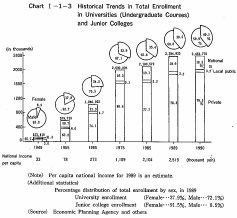| Home > Policy > White Paper, Notice, Announcement > White Paper > JAPAMESE GOVERNMENT POLICIES IN EDUCATION,SCIENCE AND CULTURE 1990 > PART |
||
In response to a wide range of demands for higher education, institutions of higher education in Japan have continued to expand. The total number of universities and junior colleges which had been 492 in 1955 reached 1,100 in 1990 and the total enrollment therein which had been 580,000 in 1955 reached 2,462,000 in 1990.
The proportion of the age group advancing to universities, junior
colleges and colleges of technology reached 36.8% in 1990. The proportion of
the age group going on to institutions of higher education, including special
training schools (advanced courses), amounted to 53.7% in the same year. In other
words one-half of the age group has gained access to higher education. (See
Chart ![]() -2-2)
-2-2)
Chart ![]() -1-3 shows historical trends in total enrollment in
universities and junior colleges since the end of World War
-1-3 shows historical trends in total enrollment in
universities and junior colleges since the end of World War ![]() . This chart indicates
that the post-war expansion of higher education has been mainly attributable
to the expansion of private institutions and the increase in women students.
. This chart indicates
that the post-war expansion of higher education has been mainly attributable
to the expansion of private institutions and the increase in women students.

In 1955 graduate schools were existing in 56 universities (21 national, 4 local public and 31 private). Since then these schools have been gradually increasing along with the expansion of universities. In 1990 graduate schools were existing in 313 universities (95 national, 23 local public and 195 private) which accounted for more than 60% of all universities in the country.
Total enrollment in graduate schools in national, local public and private universities. which had been approximately 10,000 in 1955, increased to 90,000 (62,O00 in master's degree courses and 28,000 in doctor's degree courses) in 1990.
| Back to Top | MEXT HOME |